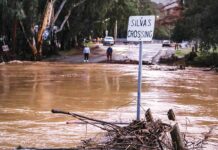Bird flu victims
An outbreak of bird flu that killed 23 tigers at a Thailand zoo
prompted officials to cull 40 other sick tigers at the same
facility to prevent the disease from spreading.
Bird flu victims
An outbreak of bird flu that killed 23 tigers at a Thailand zoo prompted officials to cull 40 other sick tigers at the same facility to prevent the disease from spreading.
The initial big cat deaths occurred after the animals were fed raw chicken bones. Earlier this year, six tigers at other zoos and two house cats died of avian influenza after eating infected raw chicken. Countries across Southeast Asia are culling various animals and switching to nonconventional methods of poultry production in an attempt to eradicate the disease.
Andean Glaciers Shrink
Ecuador’s mountain glaciers are melting at an alarming rate due to global warming, threatening the country’s future water supplies, according to researchers.
Ecuador’s Meteorology Institute and France’s scientific research institute IRD said that the towering Cotopaxi Volcano has lost 31 percent of its ice cover between 1976 and 1997, and others such as El Altar could lose all of their snow pack during the next 10 to 20 years. Ecuador’s capital, Quito, depends on snow-covered mountains for 80 percent of its water supply.
Rabid Bear Crisis
A central Romanian mayor proposed wiping out the entire population of bears in the surrounding mountains due to a man dying of rabies after being attacked by an infected bear.
Seven other people, also attacked around Brasov before the bear was killed, were vaccinated in the wake of the first rabies-related death in the country in 30 years. Officers have been dispatched to prevent bears from reaching the town’s garbage in search of food.
Deep Oil
A report in the Proceedings of the National Academy of Sciences says that vast untapped reserves of oil and methane may exist 20 miles or deeper below the Earth’s surface, providing fuel reserves for the distant future if technology can be developed to find and extract them.
U.S. scientists duplicated the conditions that exist far beneath the continents and found that a combination of pressure and temperature can cause chemical reactions that produce hydrocarbons. Dr. Russell Hemley, from the Carnegie Institution of Washington, said: “These experiments point to the possibility of an inorganic source of hydrocarbons at great depth in the Earth – that is, hydrocarbons that come from simple reactions between water and rock, and not just from the decomposition of living organisms.”
Earthquakes
Approximately 20,000 houses in China’s southwestern province of Yunnan were wrecked, and 12 people were injured, by a magnitude 5.0 quake that struck near the densely populated city of Baoshan.
• Several people were injured and some buildings were damaged in Taiwan’s Tao-yuan county when a magnitude 6.7 temblor rocked the island.
• Earth movements were also felt in eastern Japan, western Iran, northern Germany, central Chile, southern Peru and around Anchorage, Alaska.
Eruption
Far northern Indonesia’s Soputan Volcano spewed smoke and caused hot ash and lava to fall over North Sulawesi. A similar eruption last year on Aug. 18 also caused no injuries or significant damage.
Tropical Cyclones
Typhoon-weary Japan was struck by the deadliest storm in 25 years as Typhoon Tokage passed through almost the entire length of the country. At least 67 people were killed, and the storm produced widespread damage and transportation disruptions. Tokage, which means lizard in Japanese, was the 10th typhoon to hit Japan this year, breaking the 1990 record of six.
• Typhoon Nock-Ten formed to the southeast of Guam and was taking aim on far southern Japan late in the week.
Feline Defeat
An army of 700 urban cats imported to a rat-invested town in northern Mexico has done little to get rid of the more than 1.5 million rodents that are ruining crops, invading homes and terrifying residents. The mayor of Atascaderos is now offering five pesos, or about 40 cents, for every rat beaten to death.
“I don’t think (the cats) worked very well because we know a cat sees one rat, eats it, then doesn’t kill again until at least two days later,” said regional mayor Jesus Velazquez Rodriguez. He added that some members of the “cat army” were actually attacked and killed by rats shortly after their arrival.
After the magnitude of the infestation became apparent last year, farms set traps and poison, but that killed various cats and other rodent predators, which only worsened the problem. Residents now fight pitched, house-to-house battles to get rid of the rodents, according to a report in the daily Reforma.
– By Steve Newman













